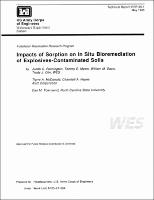Please use this identifier to cite or link to this item:
https://hdl.handle.net/11681/4820Full metadata record
| DC Field | Value | Language |
|---|---|---|
| dc.contributor | North Carolina State University | - |
| dc.contributor | Installation Restoration Research Program (U.S.) | - |
| dc.contributor.author | Pennington, Judith C. | - |
| dc.contributor.author | Myers, Tommy E. | - |
| dc.contributor.author | Davis, William M. | - |
| dc.contributor.author | Estes, Trudy J. | - |
| dc.contributor.author | Hayes, Charolett A. | - |
| dc.contributor.author | Townsend, Daniel M. | - |
| dc.contributor.author | McDonald, Tiarre | - |
| dc.creator | AScI Corporation | - |
| dc.date.accessioned | 2016-03-17T18:44:29Z | - |
| dc.date.available | 2016-03-17T18:44:29Z | - |
| dc.date.issued | 1995-05 | - |
| dc.identifier.uri | http://hdl.handle.net/11681/4820 | - |
| dc.description | Technical Report | - |
| dc.description | Abstract: Bioavailability of contaminants in soils may depend upon the concentration of the contaminant in the solution phase, which in turn is dependent upon the ease with which the contaminant moves from fixed states into the solution phase. When bioremediation is the goal, enhancement of bioavailability by increasing solution phase concentrations of the contaminant may be necessary. Objectives of this study were to characterize desorption of TNT, RDX, and HMX in soils and to enhance solution phase concentrations by using surfactant and hot water. Desorption kinetics and isotherms were determined on four explosives-contaminated soils using shake tests. Isotherms were determined for aqueous, surfactant, and hot water challenges. Column leaching experiments were performed using one of these soils and aqueous challenge over a period of 35 days. Results indicated that soil concentration of explosives exerts an important impact upon solution phase availability. When explosive concentrations in soils were sufficiently high to produce free product in the soil, solubilization was the dominant mass transfer process. When concentrations were low, desorption, convection, and dispersion controlled solution phase concentrations. Surfactants generally increased solution phase concentrations of explosives; however, effectiveness was less dramatic in soils having limited explosives concentration. Hot water also increased solution phase concentrations, but was not as effective as surfactants. High concentrations of explosives in the solution phase of soils are potentially toxic or inhibitory to the degrading microflora. Under land farming biotreatment, rates for injecting nutrients, surfactants, or hot water must be controlled so that contaminants are degraded fast enough in the biologically active zone to preclude leaching into groundwater. For injection/extraction well in situ bioremediation, flow rates must be optimized for maximum degradation rate, and extraction must be efficient if degradation is incomplete. Surfactants may be unnecessary in highly contaminated soils if solution phase concentrations of explosives are already as high as microbial populations can tolerate. In soils exhibiting iow concentrations of expiosives where soiution phase concentrations are determined by desorption, convection, and dispersion, mobilization and migration occur readily, but may be enhanced by addition of surfactants. | - |
| dc.publisher | Environmental Laboratory (U.S.) | - |
| dc.publisher | Engineer Research and Development Center (U.S.) | - |
| dc.relation | http://acwc.sdp.sirsi.net/client/en_US/search/asset/1004534 | - |
| dc.rights | Approved for public release; distribution is unlimited. | - |
| dc.source | This Digital Resource was created from scans of the Print Resource | - |
| dc.subject | Explosives | - |
| dc.subject | HMX | - |
| dc.subject | RDX | - |
| dc.subject | Sorption | - |
| dc.subject | Surfactants | - |
| dc.subject | TNT | - |
| dc.subject | Bioremediation | - |
| dc.subject | Soil pollution | - |
| dc.title | Impacts of sorption on in situ bioremediation of explosives-contaminated soils | - |
| dc.type | Report | en_US |
| Appears in Collections: | Technical Report | |
